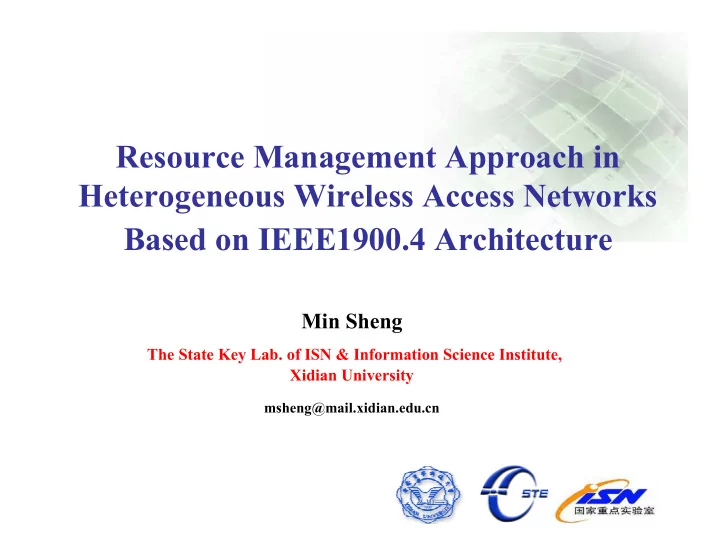

Resource Management Approach in Heterogeneous Wireless Access �etworks Based on IEEE1900.4 Architecture Min Sheng The State Key Lab. of IS� & Information Science Institute, Xidian University msheng@mail.xidian.edu.cn
������� � ��������������������������� � �������������������� � ���������� � ������������������������������������������������ ��� ���� � �!����������"�#��#������������� � $���������� � %������ ����
��������������������������� � Diverse coexisting Radio Access Technologies (RATs) with cognitive ability are the most important features of future wireless systems, which form heterogeneous cognitive wireless networks. A cognitive network is a network with GOALS a cognitive process that can perceive OBSERVE current network conditions, and then plan, decide and act on those Monitoring PLA� ACT Context conditions. The network can learn Dicision Discovery Optimization Reconfiguration from these adaptations and use them to make future decisions, all while Profiles Policies taking into account end3to3end goals. Feedback3�ew Knowledge �������������� , ������������������������������ ���������������������� �� !��"��#�$�%&�'���������&�(�����������%���� ����&)��)��&�*��+��������,�-���� ��.
��������������������������� �������������������� � �����!�������6���)������������� � ��"��)�������9������ ��� �������� ��� ��������)��������!������������ �������������� ����������� ���� � "����������������������������6��)��� �#��)�*����� �"������������"��#�����) 1���������#��������##������� ������ �������������������)�����)���� ���)��������������9�����!��6�������� � ������� ���&���'����'�(��������������������������"����#��)�*���+�����+��������,��������-������������ .���������������/�� ����0�1���������������.�������2���#3'������$�))�����������4���*����� 5�����6�7���'##�778�7�
��������������������������� � �������������� ���� � In the European projects End3to3End Reconfigurability (E2R II) and End3to3End Efficiency (E3, and in Japanese projects on SDR and CR systems, the study of JRRM which deals with the radio resource allocation among RATs have been studied. � In paper “A fuzzy3neural based Approach for Joint Radio Resource Management in a beyond 3G framework ”, a fuzzy3neural based approach for JRRM in the B3G framework is introduced. � In paper “�etwork Selection in an Integrated Wireless LA� and UMTS Environment Using Mathematical Modeling and Computing Techniques ” a scheme is brought forward to solve the JRRM problem in cellular networks. � In paper “Adaptive Threshold Joint Load Control in an End3to3end Reconfigurable System ”, the authors present an adaptive threshold joint load control mechanism. � A noncooperative game3theoretic framework for Radio Resource Management in 4G heterogeneous wireless access networks is present in “A �oncooperative Game3Theoretic Framework for Radio Resource Management in 4G Heterogeneous Wireless Access �etworks “, while cognitive ability is not considered. / ��
+��������4�����)�����##������������ ����������������������� Heterogeneous Wireless �etwork scenario
+��������4�����)�����##������������ ����������������������� Inter3�etwork: Maximum resource utility assignment policy Intra3�etwork: Dynamic resource reservation policy
+��������4�����)�����##������������ ����������������������� Inter3network resource allocation RA� Resource RRM Reservation Access �etwork Selection
�����8��� ����+������������������ � Objective of inter3network resource allocation � Allocate bandwidth dynamically compatible with the network environment to a particular service area from each of the available networks in that service areas � so that all of the service providers are satisfied. � When the network environment changes, such as the traffic intensity and the distribution of users, the system resources are reallocated
�����8��� ����+������������������ �� ����������������������������� � The neural network model Original Forecasting Data �eural �etwork Data Input Concealed Output Training Process Back Forward History Data: m Layer Layer Layer =Forward Propagation Propagation Propagation (i<=m) (k) (p) (1) +Back Propagation x − i k � i x − T − i ( k � ) i ˆ i x � � � x − i �
�����8��� ����+������������������ �� ����������������������������� � The neural network model Original Forecasting Data �eural �etwork Data Input Concealed Output Prediction Layer Layer Layer Process (k) (p) (1) x − − m ( k � ) x ˆ m x − − m ( k 7 ) + � � � � x m
�����8��� ����+������������������ B. Maximum �etwork Resource Utility � ����������������������������#������'� ��������������6�"���������"� �������#�� = α : con ; U w ���: b ; i x ' : con ; � .��������������������������6��"���� ���� i "�������������������� ������"� b U i x ' α �������������� x ������)������ w ������������������������������������� �����������������#���"�����������6�"������� �� = 1����������!������������ ����������������� ��������� B m '� ∑ = m B B c1 '� B c2 '� B l1 '����� B l2 '����#����!��6��>��� m i ����������� i m = m i � �)������"����� ������""������6�.4�/��������� i '����� � c B c � 7 m c 2 ���� c 3 ����������� ������""������6������������� ���� + = = c c B B l 7 B m m ��������7����������<'��������� c 4 ���� c 5 ����������� ����� 7 < c � < B l � �""������6������������� �����������������������='����� B c c + = � 7 c c B m ���� B l1 ���� B l2 ������������)������"����� ����� 7 � = c 7 �!��������"��)�.>�/� ��������<����������=��
Recommend
More recommend